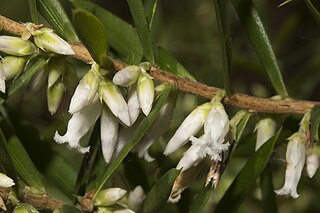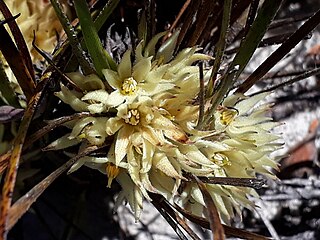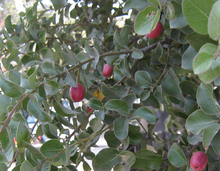
Hemiandra is a genus of nine species of flowering plants of the family Lamiaceae and is endemic to Western Australia. Plants in the genus Hemiandra are shrubs with sessile leaves arranged in opposite pairs, petals with five lobes arranged in two "lips" and the fruit a capsule usually containing four nuts.

Bulbine bulbosa, commonly known as bulbine lily, native leek, golden lily, or native onion, is a species of flowering plant in the family Asphodelaceae and is endemic to Australia. It is a perennial herb with thick roots, channelled leaves, and yellow flowers with hairy stamen filaments.

Isotoma is a genus of annual and perennial herbs in the family Campanulaceae and are native to Australia and New Zealand.

Acrotriche is a genus of about 18 species of flowering plants in the family Ericaceae, occurring in all states of Australia except the Northern Territory. Plants in the genus Acrotriche are shrubs with hairy branchlets, leaves with more or less parallel veins and small flowers with 5 sepals and petals joined at the base to form a bell-shaped to cylindrical tube with hairs and stamens in the throat.

Ptilotus is a genus of approximately 125 species of flowering plants in the family Amaranthaceae, and is endemic to Australia, apart from Ptilotus conicus that also occurs in Malesia. Plants in the genus Ptilotus are annual or perennial herbs or shrubs with usually hairy spikes of compact spherical, oval or cylindrical flowers.

Lobelia purpurascens, commonly known as white root or purplish pratia, is a flowering plant in the family Campanulaceae of eastern Australia. It is a small herbaceous, scrambling plant with white to pale pink flowers.

Wurmbea dioica, commonly known as early Nancy, is a species of plant in the family Colchicaceae and is endemic to Australia. It is a herb with three linear to thread-like leaves and usually two to seven white flowers with a purple or greenish nectary band.

Lissanthe is a genus of about 10 species of flowering plants in the family Ericaceae and is endemic to Australia. Plants in the genus Lissanthe are small, erect to spreading shrubs with egg-shaped to oblong leaves. Up to 17 bisexual flowers are arranged in leaf axils or on the ends of branches, the 5 petals joined at the base to form a cylindrical to urn-shaped tube with triangular lobes.

Cryptocarya glaucescens, commonly known as jackwood, silver sycamore, native laurel, brown beech, bolly laurel or brown laurel, is a species of flowering plant in the laurel family and is endemic to eastern Australia. Its leaves are lance-shaped to elliptic, the flowers cream-coloured or pale green, perfumed and tube-shaped, and the fruit a black drupe.

Cryptocarya obovata, commonly known as pepperberry, white walnut, long tom, she beech or purple laurel, is a species of flowering plant in the laurel family and is endemic to eastern Australia. It is a rainforest tree with oblong to egg-shaped leaves, the flowers creamy-green, tube-shaped and unpleasantly perfumed, and the fruit a spherical drupe with white or cream-coloured cotyledons.

Trochocarpa is a genus of about 16 species of flowering plants in the family Ericaceae native to Australia, New Guinea, Borneo and Malesia. Plants in the genus Trochocarpa are shrubs or small trees, the leaves with more or less parallel veins, flowers in small clusters, each with 5 sepals, petals joined to form a cylindrical or bell-shaped tube, and the fruit a more or less spherical drupe.

Cryptocarya triplinervis, commonly known as blackbutt, three-veined cryptocarya, brown laurel or three-veined laurel, is a species of flowering plant in the family Lauraceae and is endemic to eastern Australia. It is a tree with egg-shaped to elliptic or lance-shaped leaves, cream-coloured to pale green flowers, and elliptic black drupes.

Melichrus is a genus of flowering plants in the family Ericaceae, and is endemic to eastern Australia. Plants in the genus Melichrus are shrubs with narrowly egg-shaped leaves crowded at the ends of branches and bell-shaped or urn-shaped flowers arranged singly in leaf bases, the fruit a drupe.

Acrotriche divaricata is a species of flowering plant in the family Ericaceae and is endemic to New South Wales. It is a bushy shrub with sharply-pointed lance-shaped leaves and spikes of 3 to 5 green or cream-coloured flowers and spherical, red drupes.

Chloanthes is a genus of four species of flowering plants in the family Lamiaceae and is endemic to Australia. Plants in this genus are shrubs with hairy foliage, blistered or wrinkly leaves and flowers with five petals fused at the base, usually with two "lips".

Stenanthera is a genus of flowering plants in the family Ericaceae. Most are low shrubs with leaves that are paler on the lower surface, tube-shaped flowers and with the fruit a drupe. There are three species, formerly included in the genus Astroloma.

Pityrodia salvifolia is a flowering plant in the mint family Lamiaceae and is endemic to Queensland. It is an erect, spreading shrub with aromatic, wrinkled or corrugated leaves and clusters of small flowers with white petals. It is mostly found in wet forests in coastal north Queensland.

Styphelia propinqua is a species of flowering plant in the heath family Ericaceae and is endemic to the south-west of Western Australia. It is an erect, rigid shrub with linear leaves and white tube-shaped flowers that are bearded inside.

Styphelia margarodes is a species of flowering plant in the heath family Ericaceae and is endemic to near-coastal areas of eastern Australia. It is an erect, spreading shrub with egg-shaped leaves with the narrower end towards the base, and small numbers of white, tube-shaped flowers usually arranged singly or in pairs in upper leaf axils.

Conostylis breviscapa is a rhizomatous, tufted perennial, grass-like plant or herb in the family Haemodoraceae and is endemic to the south-west of Western Australia. It has flat leaves and yellow, hairy, tubular flowers.




















